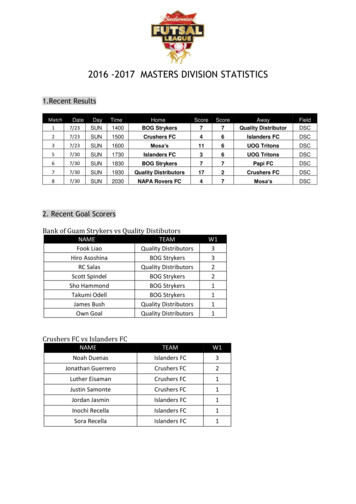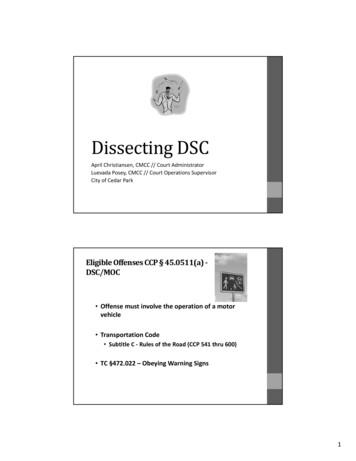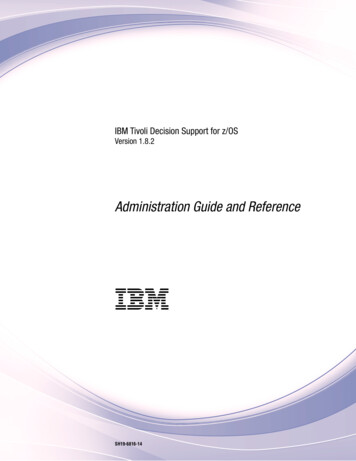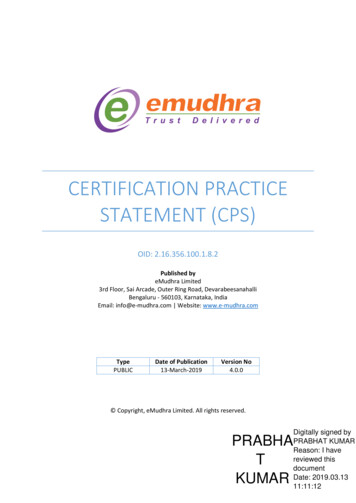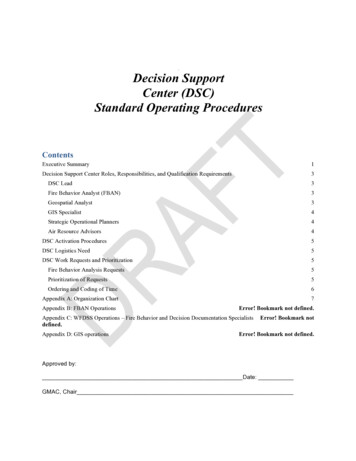
Transcription
Decision SupportCenter (DSC)Standard Operating ProceduresContentsExecutive Summary1Decision Support Center Roles, Responsibilities, and Qualification Requirements3DSC Lead3Fire Behavior Analyst (FBAN)3Geospatial Analyst3GIS Specialist4Strategic Operational Planners4Air Resource Advisors4DSC Activation Procedures5DSC Logistics Need5DSC Work Requests and Prioritization5Fire Behavior Analysis Requests5Prioritization of Requests5Ordering and Coding of Time6Appendix A: Organization Chart7Appendix B: FBAN OperationsError! Bookmark not defined.Appendix C: WFDSS Operations – Fire Behavior and Decision Documentation Specialistsdefined.Appendix D: GIS operationsError! Bookmark notError! Bookmark not defined.Approved by:Date:GMAC, Chair
Executive SummaryThe Decision Support Center (DSC) can be utilized in preparation for and during periods of highfire activity in support of a specific GACC’s Coordinating Group, Incident Management Teams(IMTs) and local units. The co-location of Wildland Fire Decision Support System (WFDSS)technical experts, fire behavior specialists, strategic operational planners and GIS specialistsmakes it possible to assist with incident prioritization, resource allocation, and offers a commonpoint of contact for all fire managers within the geographic area.The purpose of the DSC is to provide a broad range of decision support and risk managementproducts to a wide spectrum of users, facilitating critical decision support in relatively short timeframes. Examples include fire behavior analysis, WFDSS decision support, wildfire assessmentsand GMAC prioritization. This allows for critical decision support in relatively short timeframes. The DSC will: Work for the Geographic Area Editor (GAE) and GMAC group.Provide fire behavior predictions, incident fire behavior analyses, and maps of fireactivity for the geographical area coordination group.Ensure consistency with guidelines of each Agency by working with Regional Agencycontacts on policies and procedures.Initiate analysis on the request of local units for emerging incidents without regard toAgency.Provide analysis, as requested, for Federal Management Assistance Grants (FMAG).Provide general WFDSS documentation expertise, as requested by local units.Support the geographical area coordination group or GMAC, as requested, includingassistance with prioritization of incidents.Products and Support: The DCS can provide the following:ü Fire behavior analyses and interpretation support for local units, incidents, IncidentManagement Teams, Area Command, (Fire Spread Probability (FSPro), Near Term FireBehavior, FARSITE, Short Term Fire Behavior, Flammap etc.)ü WFDSS Decision support, including Decision Documentation assistance;ü Values Inventory (VI) and Values at Risk (VAR) assessment;ü Short and long term assessment and strategic planning;ü Fire Behavior and Fuel Condition Outlooks and Advisories;ü On scene or virtual support from Missoula.The DSC works for the Geographic Area Editors (GAE) and area Coordination Group and ismanaged by an assigned Decision Support Lead who has broad knowledge of Decision Supporttools (as available, a Geographic Area Editor). Staffing will scale up and down based on thePreparedness Level and the number and complexity of active incidents burning in theGeographic Area. When fully engaged, the group will likely include the DSC Lead, an FBAN,1 Page
two (or more) Geospatial Analysts (GSAN), two (or more) Strategic Operations Planners(SOPLs), two (or more) Long Term Analyst (LTAN), a WFDSS decision documentationtechnical specialist, an ARA (Air Resource Advisor(s), and a GIS specialist(s). The DSC Leadwill coordinate with the GMAC (or Agency representative during periods of less fire activity)and assign work among the group. The intent of the SOPL position is to provide direct, on-sitesupport to those Agencies incurring incident activity. The SOPLs and/or WFDSS DecisionDrivers could be strategically located throughout the GACC. Any of the other analyst positionsmay be placed strategically within the GACC.The DSC is expected to interface with GACC Coordination Center (CC) personnel on a regularbasis, particularly Intelligence and Weather. The DSC Lead will work with CC personnel tocreate products and consistent outputs, recognizing that as CC capacity is reached, there could bea need for additional staffing in the DSC.2 Page
Decision Support Center Roles, Responsibilities, and Qualification RequirementsThe following position descriptions are intended to be a guide of the role these standard firequalifications may fill within the DSC. These may change depending on these needs of thespecific fire season, GACC or local unit needs.(Depending on workload, one person may fill more than one role)DSC Lead Reports to the MAC Chair (when activated) and/or the GAEs. In situations when theGAE is not functioning as the DSC lead, there should be close coordination with theGAE’s within the GACC and the assigned DSC lead.Coordinates policies and procedures with the Regional WFDSS/Analyst for each Agency.Supervises the rest of the DSC group.Coordinates staffing and ordering of resources for the entire DSC groupResponsible for coordinating requests from incidents, assigning tasks, and overseeingtimely delivery of products.Coordinates data needs and products with CC staff.Recommended skills: broad knowledge of decision support tools (Geographic AreaEditor, if possible), strategic fire operations, and ability to lead a team effectively.Fire Behavior Analyst (FBAN) Produce or update fire behavior advisories.Provide short-term weather and fire potential overview for GMAC.Gathers input and intelligence on fire behavior from FBANs/LTANs in the field or withIMTs. Coordinates and disseminates information among field and/or IMTFBANs/LTANs to insure information is being shared regarding fire behavior conditions.Prepares a daily fire behavior/fire potential forecast for the GACC supporting .Reviews and provides feedback to fire behavior specialists on products, as needed.Recommended skills: red card qualified FBAN or LTAN.Review and update NWCG pocket cards.Trainees are encouraged, but any products they produce need to be reviewed by anexperienced fire behavior specialist or a fully qualified LTAN/FBANSupport Fire Analyst This position may be activated at any time workload demands.Responsible for completing specific technical analyses utilizing a range of fire behaviormodels, including BEHAVE, FARSITE, FLAMMAP, FSPRO, STFB, NTFB and others.This position needs to have oversight by a fully qualified analyst.Responsible for completing appropriate documentation for every fire behavior analysisand filing each analysis.3 Page
Recommended skills: red card qualified FBAN, LTAN, or GSAN or other THSP forWFDSS. Fire Behavior Specialist qualification in WFDSS is required. Mustdemonstrate competency with fire behavior models (e.g., FARSITE (NTFB) andFSPRO).GIS Specialist Coordinates with the Fire Analyst and Fire Behavior Specialist to produce products forthe GMAC, incidents, and Agencies (as requested).Provides data to update websites, web pages, and ftp sites.Completes tasks according to work priorities; files products in appropriate folders andnotes updates.Recommended skills: red card qualified GISS.Strategic Operational PlannersIt has been highly successful to have roving SOPL’s connected to the DSC in the field to supportemerging type III fires. Longer term incidents such as type I/II should likely have SOPL’sassigned to the incident if possible. Provides Federal Agencies with support in documenting fire decisions in WFDSS. Keeps track of decisions and notifies DSC Lead of fires that may need a decision or anupdated decision. Assists with the development of MAP’s, coordinates meetings with the appropriatepersonnel – stake holders, IMT’s, local units etc. Summarizes fires to describe long-term implications. Coordinate with Fire Behavior Specialist to ensure products are available for Decisiondocumentation. Recommended skills: experienced with WFDSS decisions and assisting others throughthe process. Ability to work with multiple Federal Agency requirements for decisionmaking.Air Resource Advisors Reports directly to the DSC lead. Should coordinate closely with the regular regional program leads for air quality and stateair quality agencies. Provide specific smoke modeling forecast for incidents Short duration and/or emerging incidents can be supported virtually from the DSC. Longduration fires or complex incidents should be supported with an on-site ARA. Typically, type III fires can be supported by one of the regular USFS air quality specialistvirtually. Disseminate this information out to the IMT’s ie: PIO’s, Plans, and other personnel whoare interacting or engaging with the publics through various meetings etc. The ARA and fire behavior analyst should be in close coordination so the fire behaviorprojections can be included in the smoke forecast.4 Page
DSC Activation ProceduresActivation will occur at the request of the GMAC or at any time one of the Agencies within theGACC reaches capacity on producing decision support related products. The Geographic AreaEditor for each federal agency is key in determining when capacity has been reached. Thiscapacity is normally reached at a PL 3 or 4. Generally, it is highly recommended to activate theDSC when a MAC group is activated.DSC Logistics NeedThe DSC can be staffed with a wide range on numbers of personal and be on site or virtual.Therefore, the workspace is flexible. However, the ideal situation is co-located with the GMACand CC plus the ability to accommodate up to 12 people. Computer workspace for up to 12 personnel (desk, power, internet access for multiagency employees). 3 phones, at least one with speakerphone capabilities and webcam Color Printer. Plotter (if available). Copy machine (availability @ CC or other office may work). Office supplies (pens, highlighters, staplers, 3 hole punch, copy paper, sticky notes,writing tablets). MAC/CC phone list. Functionality to display information on a large screen such as a large screen TV and/orhook up to a projector.DSC Work Requests and PrioritizationFire Behavior Analysis RequestsGenerally, the GAE is aware of requests for fire analyses on incidents within their respectiveGACC. This is due to close coordination with the local units and/or contact with the regionalduty officer. The GAE will task the DSC to fulfill requests. If the GAE is not already assignedto the DSC, then they will contact the DSC lead.When a request for an analysis is submitted in WFDSS, there is no automated way to alert theFire Behavior Specialists that a request exists. If a local Fire Behavior Specialist is not available,the local incident needs to contact the DSC Lead or Fire Behavior Specialist to ask forassistance. The DSC will monitor fire behavior requests in WFDSS and keep track of analysisneeds.If an incident is expected to be long duration and/or needs extensive analysis for management ofthe fire, it is generally recommended to have a local analyst. The DSC Lead may assist infinding a qualified analyst to work locally. Generally, if a fire is managed by a Type 1 or 2 IMT,local analyst capabilities are recommended (i.e., the analysis should be done by someone at theincident, not at the DSC). However, during times of high fire activity across the nation, this maynot be possible due to resource shortages.Prioritization of RequestsThe DSC Lead will coordinate requests with the Jurisdictional Agencies. Approval of theprioritized list will be done by the GMAC group. The prioritization may include but not belimited to the following considerations:5 Page
Emergent firesFires in proximity to identified valuesFires without obvious natural barriersFires with long-term potentialPolitically or sensitive firesFires with potential for high costsOrdering and Coding of TimeAll resource orders for staffing the DSC will be coordinated through the DSC Lead. All DSCresources will be ordered on the CC or USFS RO support code. In order to deal with shortsurges of workload, virtual analysts may be utilized. These virtual analysts will report to theDSC Lead and their assignments will be managed in conjunction with the other on-site analysts.6 Page
Appendix A: Organization Chart7 Page
Appendix B SOPSForest Service[Document title][Name][Date]8 Page
The intent of this Standard Operation Procedure outline is to provide a starting point orconsiderations for Regional Staffs to initiate the discussion to stand up a DecisionSupport Center. As of April 02, 2020, this is a draft guide, it is our intent to pass thisguide to the Region for further development. The guide should be considered a fluiddocument, one that can be added or updated as needed and not become static overtime. Please share this information with the other Geographic Area Editors (GAE’s)within respective Regional Geographical Area in addition to the other GAE’s in otherAreas. Additionally, if updates or other considerations are included please share thatinformation with the above discussed audiences but also with the Wildland FireManagement Research, Development and Application (WFM RD&A) group.9 Page
Standard Operating Procedures for Functional Areas of a Decision Support Center (DSC)Contents1. Standard Operating Procedures for DSC lead112. Standard Operating Procedures for Analysis Group. 133. Standard Operating Procedures for FBAN Group . 134. Standard Operating Procedures for SOPL . 135. GISS Standard Operating Procedures . 146. ARA Standard Operating Procedures . 29Appendix 1. Helpful Links: Setup and User Accounts . 3110 P a g e
1. Standard Operating Procedures for DSC leadThe following represents a general flow to the day. The times listed are a general guide. Thespecific times changed over the course of the nearly two months the DSC was activated.1. 0600 – 0700 Arrive at DSC, gather situational awareness of weather/fire behavior/update onincidents. See section in Appendix on helpful links. It is helpful to have a full timemonitor/projector with PC to be able to display current incidents, fire wx and NFDRSinformation. Utilize a WFDSS group for critical incidents in the GACC to pull fireperimeters, analysts, and M.A.P.s.2. 0700 – 0830 Connect with Center Manager and Regional Operations. Find out new or emergingincidents or changes with priorities. Update them on any critical informationdeveloped by the DSC. Determine what critical questions need to be addressed bythe DSC during the shift. Prepare for DSC briefing by insuring all incident requests(analysis, WFDSS decisions and any special products) are covered.3. 0830 – 0900 DSC briefingThis briefing is for all staff (on site and virtual) for the DSC. The following was used as anagenda and should be confined to no more than 30 mins: Roll callDSC Lead Regional overviewDSC Lead Fire Wx/Fire behaviorFBAN SmokeLead ARA GMACMAC Coordinator LTANsLead LTAN SOPLsLead SOPL Round robinThe following breaks down the objectives for each agenda item of the call:§ Roll callDSC LeadConfirm attendance of all DSC members§ Regional overviewDSC LeadProvide a general summary and update on MAC priorities, outlook for activity (continueddry wx, increased probability for activity, etc.), updates on feedback from the field,GMAC, etc.§ Fire Wx/Fire behavior FBANProvide a regional overview of fire wx/fire behavior/fire danger for the GACC. Utilizeproducts from predictive services and special products developed such as ERCinteractive map, etc.§ SmokeLead ARAProvide an update on outlooks, smoke modeling for incidents, priorities§ GMACMAC CoordinatorUpdate on any emerging issues, product needs§ LTANsLead LTANA lead LTAN may need to be established during times of high staffing to help with span ofcontrol for the DSC. Topics covered should include current analysis, critical issues, needsand priorities§ SOPLsLead SOPLA lead SOPL may need to be established during times of high staffing to help with spanof control for the DSC. Topics covered should include current decision work, criticalissues, needs and priorities§ Round robin4. 0900 – 0930 breakouts for any of the specific sections (LTANs, ARAs, SOPLs) and follow updiscussions5. 0930 – 1000 Aviation briefing11 P a g e
This is a briefing for IA resources such as lead plane pilots, air attacks,smokejumpers. This should include a briefing by the predictive services IMET and theFBAN from DSC. The briefing time for both fire wx/FBAN should be 5-7 mins. FBANtopics should include the NFDRS indices to illustrate fire potential across the GACC,highlight critical areas and implications for IA resources.6. 10:00 – 10:30 Coordination Center Floor briefing The DSC lead and FBAN should attend this briefing FBAN should coordinate with the GACC IMET to provide an overview ofcurrent and predicted fire potential across the GACC DSC lead – gather intel on incidents to help prioritize needs and productdevelopment. Give a very brief overview of which incidents are currentlybeing supported from DSC.7. 10:30 – 13:00 This is an open time block. It is recommended to use this time to organizeand prioritize information from the morning briefings, assign or update tasksto DSC members and connect with DSC staff to check on progress or helpwith needs.8. 13:00 – 14:30 MAC call The DSC lead, FBAN and GISS should attend this meeting at a minimum. Ifpossible, it may be helpful for the SOPL/LTAN lead (if activated) to attend. DSC Lead - be prepared to give a very brief status update FBAN, along with the predictive services IMET should give a generaloverview on fire potential with a similar briefing format as the CoordinationCenter floor meeting GISS – should run the google earth tour. Generally the following productsshould be pulled together:§ Fire perimeters,§ Analysis§ MAPS9. 14:30 – 17:00 This is another open block of time. It is recommended to use this time toorganize and prioritize the information from briefings, assign or update tasksto DSC members and connect with DSC staff to check on progress or helpwith needs.10. 17:00 – 18:00 IC call The DSC lead should attend this call. This is a call coordinated for theCoordination Center and all the ICs in the GACC. This provides anopportunity for gathering intel and providing updates on DSC servicesavailable to support the IMTs. This call may help provide information to theDSC on potential gaps of service the incidents needed. The GISS should drive the google map with the same type of informationused for the 1300 MAC call. The FBAN and SOPL also may attend this call for general informationgathering and situational awareness from incidents.11. 18:00 – 18:30 MAC call This call is utilized to prioritize the incidents. The DSC lead may or may notbe requested to attend this call12. 18:30 – 20:00 Close out and administrative work for the day. It is recommended to use thistime to help prioritize support to the incidents based on new priorities fromthe MAC group from the 1800 MAC call. 12 P a g e
2. Standard Operating Procedures for Analysis Group The Fire Behavior Specialist Lead responsibilities should be accepted from the outset when theDSC is created. Initially, those responsibilities may be held by the DSC Lead. As soon as anindividual is assigned for fire analysis and long term assessment of incidents, the responsibilitiesshould be assigned to that individual. Ideally, the Lead should be fully qualified as LTAN, andalso be prepared to lead an expanding group of specialists. Additionally, they should haveexperience and skill with analysis in the geographic area;The Fire Behavior Specialist Lead coordinates analysis support for regional priorities, local units,incident management teams and other entities as assigned by the DSC Lead. This coordinationincludes efficient distribution of analysis responsibility, mentor/trainee combinations, and otherneeds as identified. Coordination should include interaction and coordination with fire behaviorspecialists assigned in other ways; with incident management teams or administrative/local units;The Fire Behavior Specialist Lead is responsible for review of analyses, providing feedback andencouraging discussion among analysts to ensure consistency and accuracy of inputs whereappropriate, quality of results, and documentation of the analysis work;The Fire Behavior Specialist lead is also responsible for tracking assignments, accomplishments,issues, and feedback in behalf of the entire group doing analysis.3. Standard Operating Procedures for FBAN Group Continuous logging of products, briefings, and FBAN output needs to be ongoing throughout theDSC timeline. An outline to capture these should be developed and implemented when the nextDSC is stood up;Documents and briefing products need to be located on the shared DSC drive immediately;Listing accessed url’s and data sites for continuity of products and shared intelligence gathering;If the DSC FBAN is supporting other incidents, additional FBANS may need to be considered tomanage workload.4. Standard Operating Procedures for SOPL Provide oversight to decision documentation - assess the needs to develop or update decisiondocumentation;Evaluate the consistency of decision documents at the forest and/or the regional level to provideconsistency/continuity to the documentation additionally provide recommendations or feedbackfor improvements as needed to the DSC lead and/or the Regional contact as appropriate;Work with IBA or finance section chiefs to assess actual cost projections for the decision.Coordinate workload with the DSC lead, and LTAN support or LTAN Lead (if stood up) clearlyidentify the analysis needs to support the decision documentation;Prioritize workload for LTAN’s supporting the decision documentation or SOPLs working for theDSC either in place or virtually;If the DSC and fire activity supports the workload consider ordering additional SOPLs or SOPLt toassist with workload or to provide a different exposure to trainees;When possible plan to spend time in the field to conduct face to face meetings, data/informationgathering and presentation of MAPS developed for the decision;Document, Document and Document information updated by yourself or the SOPL group;assistance provided, issues encountered, successes, areas for improvement - keep a unit log ordiary of events throughout your duration for either replacement SOPLs or future coordinationevents;o This information needs to be stored in a cloud like environment so it is easy to find, and thedocumentation can be maintained after demob and for future reference;Identify the key stakeholders who need to be part of the decision process, coordinate face to facemeetings which are the best or use virtual tools to help with coordination of expectations anddecision intent. Stakeholders include but not limited to: local unit representatives (fire, lineofficers, actings etc), and IMT personnel.13 P a g e
5. GISS Standard Operating ProceduresA. Setup and Establish User Accounts1. A NIFC AGOL user account is necessary for publishing Hosted Feature Layers for use in WebMaps and Web Mapping Applications used to navigate incidents during IC calls and Briefings.Obtain an account prior to incident, use the Request a NEW Account link on the Home page athttp://nifc.maps.arcgis.com/home/index.html2. Have an FTP client installed, preferably WinSCP. Request access to the relevant GACC directorywith write access including the gacc support and year MAC directories.3. Establish a wireless network connection. Typically this will be a Guest USFS (FS-Auth guest)account using your email address as the username and a password will be emailed to you oncethe account is created. The connection may be squirrely especially peak morning and eveningtimes so it may take a few logins to establish.4. A WFDSS account will be required for obtaining current incident data and uploading IRperimeters. Request a new account if needed from the Wildland Fire Decision Support System.https://wfdss.usgs.gov/wfdss proto/faces/jsp/login/WFDSSLogin.jsp5. A FAMWEB account will be required to download SIT-209 reports to add to the year MACfolder in ftp each night. If you need an account choose Ctrl FAMWEB Logon Request(window is a pop up) and fill in form accordingly. If you need help see additionalCreating A Famweb User account document in Appendix. In my Folders, create shortcut toIMSR AutoSIT Reports for quick access.6. Bookmark these sites:Fire Data in Google Earth - Remote Sensing Applications Center (RSAC) for MODIS and VIIRSFire Detection data https://fsapps.nwcg.gov/googleearth.phpNational Infrared Operations – Download NIROPS CDE KMLhttps://fsapps.nwcg.gov/nirops/FSGeodata Clearinghouse – Download National ets.php7. You will want to set up a file structure on local disk for easy navigation and download/upload offiles. Preference will vary among individuals but a standard for GIS files should be identified at thestart of the incident in the GIS Data folder.Example: Incident Data NameB. Data CollectionCollect data from sources to update feature classes in relevant GACC Fire Locations Update Map,Google Earth files, and Incident documents1. Daily IR data is collected and stored in the year fires. Download in background the .kmz andshapefile.zip files from year incident , IR, dateLessons Learned:Not all fires will receive nightly IR data so just download what was taken the night beforeEXCEPT when first loading data into the IR perimeter feature class.I like to download files into a download folder created in the MAC folder created for incident thenextract each .zip into an IR incident specific today folder. The kml files moved to a KML folder.14 P a g e
2. Download Fire Data in Google Earth.a. Select the Modis tab and download Fire Detections (MODIS): Current. Move to a Modis folderb. Select the VIIRS tab and download Fire Detections (VIIRS 375m): Current. Move to a VIIRSfolder3. Download WFDSS emerging incidents (KMZ) and recent incidents (perimeter and KMZ)Log in to WFDSS and select the Incidents tab. Select Edit Filter to create an Emerging Incidentsfilter for future use. Discovery Date of Incident Incidents discovered in last 2 days Controlled Date of Incident Any controlled date Contained Date of Incident Any contained date Out Date of Incident Fires that are not out Geographic Areas GACC of Interest Jurisdictional Agency Select all agencies Incident type WildfireSave FilterName it Emerging IncidentsThis will now be readily available in the dropdown list of Filters to select.Choose Generate KMZ and give the file a Label, this will be the name of the kmz.Click on My Home My Activities and wait until the status says Completed to download thekmz. Move the kmz files into the KML folder.Lessons Learned:The My Activities page usually does not refresh and will say In Process even if it is done. Clickthe Reload icon on your browser or press F5. I have also encountered where files fail severaltimes to package for download but keep trying and eventually they complete.Go back to the Incidents tab and Download Perimeters. Move perimeters into a shapefile folder.Give the file a Label, choose Most Recent Perimeter, and Select all Source Types and SubmitRequest.15 P a g e
4. Collect any other ancillary data needed for your maps or additional files from WFDSS. Anexample would be past fire perimeters for the area in the current year. I downloaded aspreadsheet of all fires in the GACC for 2017 which contained the coordinates.5. In the evenings, download updated Incident Action Plans (IAP) from NIFC ftp gac support, year , incident folder and save to your computer in an IAP folder.6. In the Nifc ftp year fires, incidentname , GIS, products folder look for the most current OPSmap and save to your computer in an OPS folder7. In the evenings, log into FAMWEB, National Fire and Aviation Management Sit-209 209tab Reports My Folders Shortcut to IMSR (AutoSIT) Report. Select Click Here to bring up thelist of current days 209 reports. Scroll down to the respective GACC reports and search forreports from current date. Click on the name of the incident and wait for the report to appear.Right click on report save as incidentname 209 into a 209 folder. Close and select next reportuntil all new reports have been saved. You should have a 209 pdfpw MAC.bat file in the same209 folder that will create an out folder with copies of all the 209s that are now passwordprotected. Make sure to delete the out folder before running the batch file again.8. Be sure to save updated Priorities document when the email is received.C. Data ProcessingOnce all data has been collected it needs to be processed.1. Process the 209 reports by running the 209 pdfpw MAC.bat file. An out folder will be createdcontaining new password protected 209 PDF reports.2. Rename the IAP maps to the IncidentName IAP format. This way the new files will overwrite theexisting files in Google or One Drive and in FTP3. Rename the OPs maps to the IncidentName OpsMap format. This way the new files willoverwrite the existing files in Google or One Drive and in FTP.16 P a g e
4. In the KMZ folder, rename the Incident kmz files to just the incident name. This way the new fileswill overwrite the existing files in Google or One Driv
DSC Lead Reports to the MAC Chair (when activated) and/or the GAEs. In situations when the GAE is not functioning as the DSC lead, there should be close coordination with the GAE's within the GACC and the assigned DSC lead. Coordinates policies and procedures with the Regional WFDSS/Analyst for each Agency.
